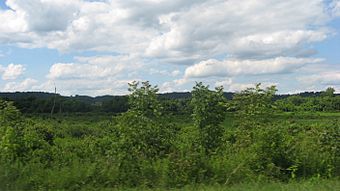Clover site facts for kids
|
Clover site (46CB40)
|
|

Looking toward the site from the south
|
|
| Lua error in Module:Location_map at line 420: attempt to index field 'wikibase' (a nil value). | |
| Location | Lesage, West Virginia |
|---|---|
| NRHP reference No. | 92001881 |
Quick facts for kids Significant dates |
|
| Added to NRHP | April 27, 1992 |
| Designated NHL | April 27, 1992 |
The Clover site (also known as 46CB40) is an important archeological site in West Virginia, United States. It is located near Lesage in Cabell County. This site was once a village of the Fort Ancient culture, a group of Native Americans who lived in the Ohio River Valley.
The Clover site is special because it has very well-preserved remains of a Native American village. This village existed during a time called the protohistoric period. This means it was just before written history began in the area. The unique items found here have made it a "type site." This means it helps archeologists understand and identify similar sites from the same time period, known as the Clover Phase of the Fort Ancient culture.
In 1992, the Clover site was recognized as a National Historic Landmark. This shows how important it is for understanding the history of Native Americans.
Contents
What is the Clover Site?
The Clover site is about 20 miles (32 km) north of Huntington. It sits on a high, flat area next to the Ohio River. This area is now part of the Green Bottom Wildlife Management Area.
Village Layout and Size
The village was quite large, covering about 5 acres (2 hectares). It had a semi-circular shape. In the middle of the village was a central open space called a plaza. Houses and living areas were built around this plaza. This layout is common for other Fort Ancient villages. Archeologists have not yet found a palisade (a strong fence for protection) at Clover, which is sometimes seen at other sites.
What Was Found at the Site?
Early descriptions of the site mentioned three raised areas, like small mounds. These were about 5 feet (1.5 meters) high and 200 feet (61 meters) wide. However, these mounds can no longer be seen today.
Investigations at the site have uncovered many interesting things made by Native Americans. These include:
- Pottery: Pieces of ceramic pots that were strengthened with crushed shells.
- Stone tools: Tools made from different types of stone.
- Bone tools: Tools made from animal bones.
- Ornaments: Decorative items.
Archeologists also found items made by Europeans. These include brass and copper ornaments, and glass trade beads. These European items are very important. They help archeologists know that the upper layers of the site date back to the protohistoric period (around 1550 to 1600). This was when Native Americans first started trading with Europeans.
Who Studied the Site?
Many people have studied the Clover site over the years. In the 1920s, people who studied archeology as a hobby, like John J. Adams and S.F. Dunett, found many artifacts. Later, in the 1940s, a professional archeologist named James B. Griffin led investigations.
The artifacts found by these early explorers helped Griffin define the "Clover Phase" of the Madisonville complex. This "Clover Phase" helps archeologists identify similar sites from the same time (1550 to 1600) in the region.
More recently, in the 1980s, Nicholas Freidin from Marshall University also studied the site. He ran an archeological field school there from 1984 to 1988. This gave students a chance to learn about archeology by working at a real site.
Today, many of the artifacts found at the Clover site are part of the John Adams Collection. This collection is kept and cared for by the Huntington Museum of Art.

